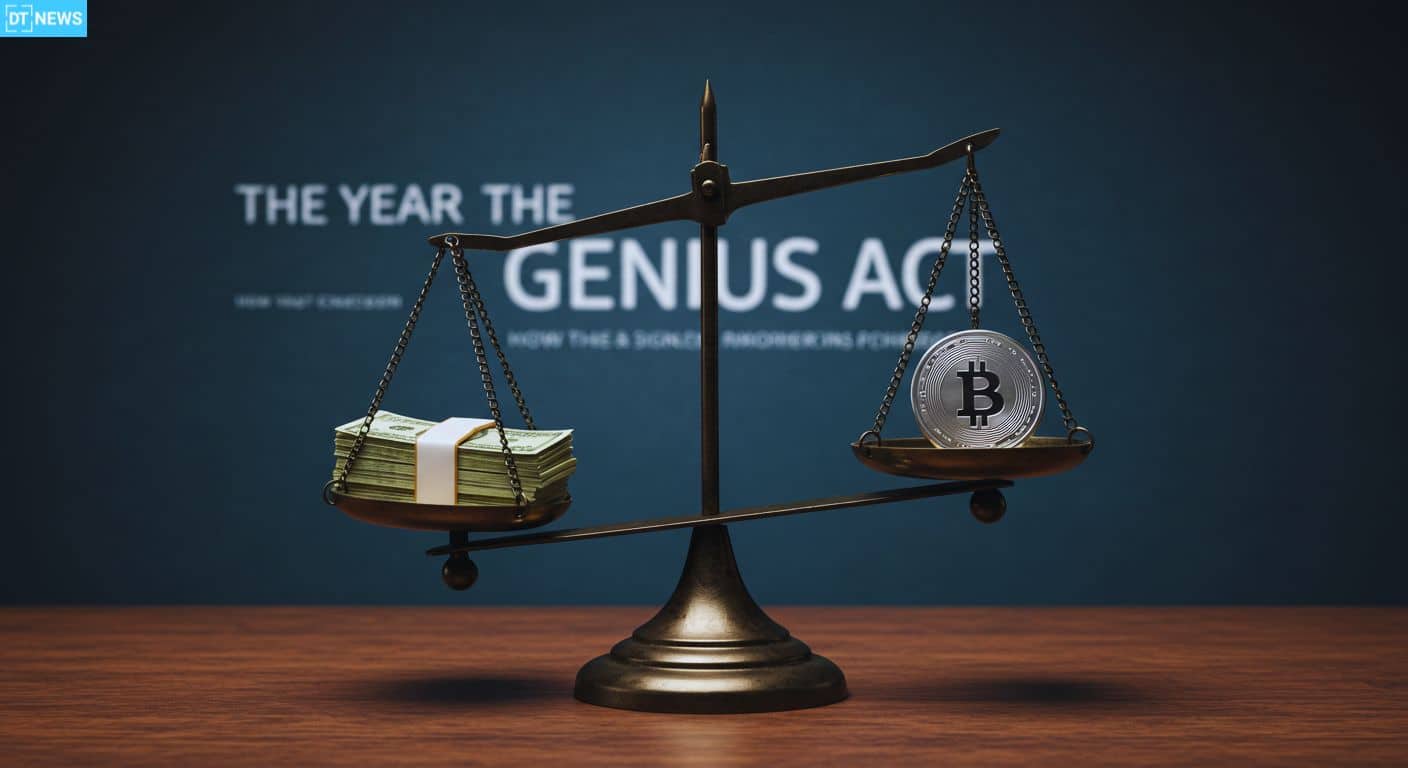According to many experts, the United States has entered what they call the “Year of the Stablecoin” after the passage of the Guiding and Establishing National Innovation for U.S. Stablecoins Act (GENIUS Act). Signed into law on the 18th of July 2025, this is the first federal law to comprehensively regulate “payment stablecoins,” thus bringing clarity to digital dollars and programmable money.
- What the GENIUS Act Actually Covers
- From Regulatory Void to Institutional Confidence
- Reinforcing Dollar Supremacy and Tokenization Infrastructure
- Utility, Not Yield: The Strategy Behind Stablecoin Innovation
- Will Political Shifts Derail the Stablecoin Train?
- Conclusion
- FAQs
- What is a payment stablecoin?
- Who can issue stablecoins now?
- Why are stablecoins banned from paying interest?
- How does the Act keep the U.S. dollar strong?
- Glossary
From Bitcoin conferences to boardrooms at JPMorgan and Circle, the impact has been immediate. Experts say the Act will accelerate real-time payments and reinforce the US dollar’s global dominance.
What the GENIUS Act Actually Covers
Passed with bipartisan support 68-30 in the Senate and 308-122 in the House; the GENIUS Act creates a dual regulatory regime with federal oversight and regulated state-level pathways.
Key mandates include full one-to-one backing of stablecoins with cash or short-term Treasuries; strict segregation of reserves; monthly public audits and no interest-bearing features. Issuers must register as Permitted Payment Stablecoin Issuers (PPSIs).
The law also gives stablecoin holders priority in bankruptcy and prohibits them from being considered securities or bank deposits. Regulators can issue daily fine or criminal penalties if necessary.

From Regulatory Void to Institutional Confidence
The GENIUS Act brings institutional certainty. Experts say previously cautious banks and fintechs are now moving fast to integrate stablecoins into risk-managed frameworks. Visa’s crypto lead called the legislation an enabler for global remittances and interoperability with existing payment rails.
Crypto-native firms also agree. Fabian Dori, CIO at Sygnum, told Cointelegraph that stablecoin issuers are shifting from yield-driven models to true payment utility. Companies like Mastercard, PayPal and Amazon are now exploring compliant use cases.
Institutional voices like Utkarsh Ahuja (Moon Pursuit Capital) and Guillaume Poncin (Alchemy) say regulatory clarity removes inertia and unlocks innovation across programmable money infrastructure.
Reinforcing Dollar Supremacy and Tokenization Infrastructure
By requiring reserves in US dollar assets and Treasuries, the GENIUS Act may inject trillions into the US debt markets. McMillan LLP estimates stablecoin issuers could rival or even surpass foreign central banks in treasury holdings.
Chris Perkins of CoinFund calls it a foundation for digital dollar adoption, especially in emerging markets where locally pegged stablecoins could be a safer store of value than local fiat.
Tokenization of assets like credit, real estate or private equity seems to be happening already, with DeFi and TradFi firms exploring use cases backed by programmable stablecoins.
Utility, Not Yield: The Strategy Behind Stablecoin Innovation
Interest-bearing stablecoins are effectively banned under the GENIUS Act’s current form. This legal choice shifts user demand to utility-based use cases, and will drive integration with DeFi protocols. Perkins warns of a coming “DeFi summer on steroids” as demand for yield across decentralized platforms grows.
Orest Gavryliak of 1inch Labs says tokenized finance enabled by stablecoins brings liquidity and settlement efficiency across borders and asset classes.
Institutions like JPMorgan are testing loan platforms collateralized by crypto holdings, building on regulated confidence that digital assets meet real world standards.

Will Political Shifts Derail the Stablecoin Train?
Despite partisan divides, many experts believe stablecoin regulation has reached a point of no return. Genna Garver, partner at Troutman Pepper Locke, says utility-driven adoption will outlast political cycles just as ATM networks built financial infrastructure.
But critics like Paul Blustein warn that stablecoin demand could be like the 19th century “free banking” era or strain U.S. Treasury markets if conditions get out of control.
Financial observers also note that long term success requires broader regulation including market structuring (CLARITY Act) and stablecoin frameworks, still pending Congressional action.
Conclusion
Based on the latest research, ‘GENIUS Act stablecoin regulation’ is the beginning of stablecoins moving from niche experiment to foundational financial infrastructure. The law brings much needed legitimacy and regulatory certainty, allowing institutions to participate and innovate in digital payments, tokenized assets and programmable finance.
While risks remain especially around yield bans and macro liquidity; the law’s clarity sets U.S. stablecoins as durable drivers of dollar growth and global interoperability.
Read more about stablecoins.
Summary
The GENIUS Act stablecoin regulation is now law in the US. It requires full reserve backing, monthly audits and regulated issuance via bank-chartered or Treasury-certified entities. Stablecoins are excluded from SEC and CFTC oversight, so institutions can trust and innovate. Experts expect to see more use cases such as remittances, tokenized assets, programmable payments and interest from banks and DeFi platforms.
FAQs
What is a payment stablecoin?
Under the Act, it’s a digital token designed for settlement, redeemable 1 to 1 for fixed monetary value, and not a security or deposit.
Who can issue stablecoins now?
Only Permitted Payment Stablecoin Issuers (PPSIs), approved either federally or via Treasury-certified state programs.
Why are stablecoins banned from paying interest?
To not compete with bank deposits and to shift yield to DeFi ecosystems regulated.
How does the Act keep the U.S. dollar strong?
By requiring T-bill and USD reserve backing, it anchors stablecoin supply to U.S. debt demand and global currency hierarchy.
Glossary
Payment Stablecoin – A USD-pegged digital token for payments, redeemable on demand at face value.
PPSI (Permitted Payment Stablecoin Issuer) – Entity licensed to issue stablecoins under the Act’s rules.
Rehypothecation – Lenders reusing client collateral; banned under the 1:1 backing rule.
Tokenization – Converting real-world assets into digital tokens, often using blockchain.
DeFi Summer – A euphemism for heightened activity in decentralized finance platforms, especially yield-seeking behavior.
Sources



















































































































